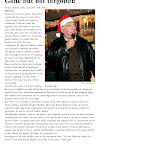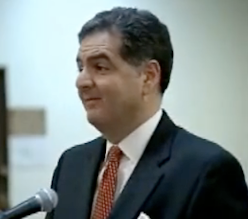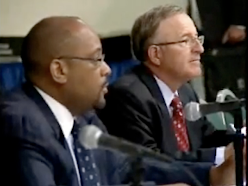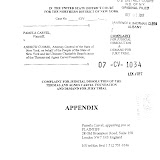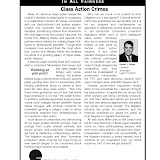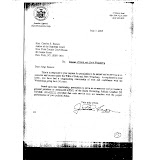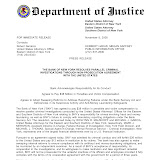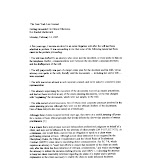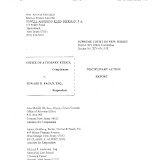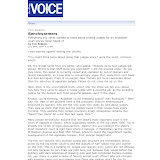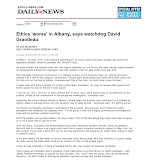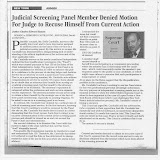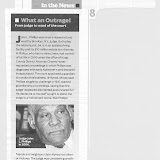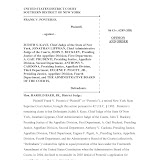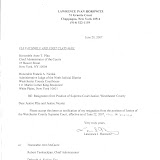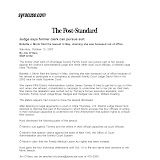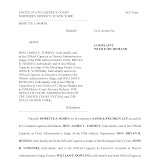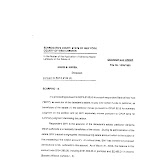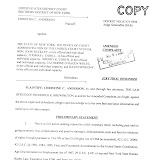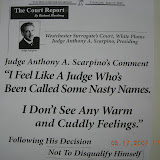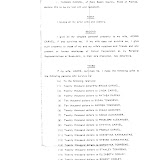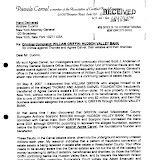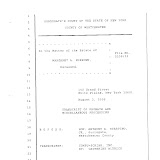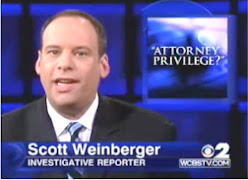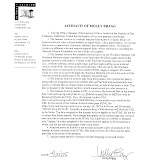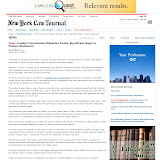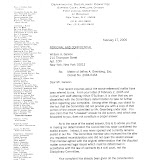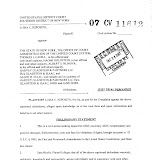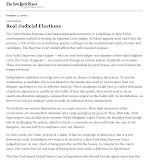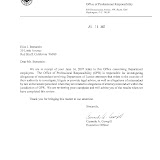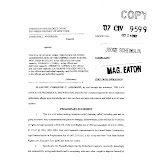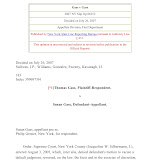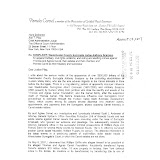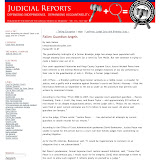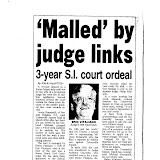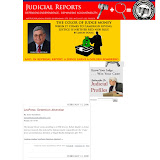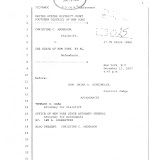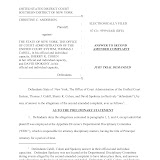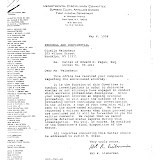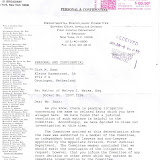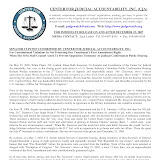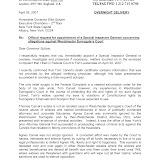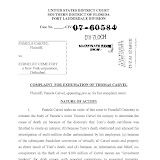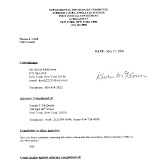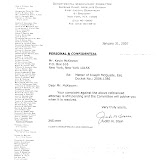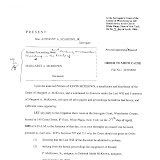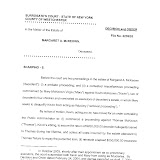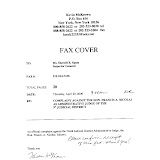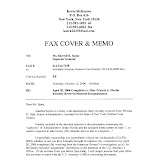The New York Law Journal by Joel Stashenko - February 26, 2010
ALBANY, NY - Denise O'Donnell resigned yesterday as Governor David A. Paterson's deputy secretary for public safety, saying she had been kept in the dark about the possible intervention of New York State Police personnel on behalf of a close aide to Mr. Paterson who had been accused of domestic violence. "I regret to inform you that recent events make it impossible for me, in good conscience, to remain a member of your Administration," Ms. O'Donnell, 62, wrote to the governor in a brief letter. "Please accept my resignation, effective immediately." Ms. O'Donnell said in a statement that she had not known about the involvement of the state police, one of the agencies she supervised, until Wednesday night after The New York Times reported that the alleged domestic violence victim had complained that the troopers had harassed her in an effort to persuade her to drop her bid for an order of protection in Bronx Family Court against David W. Johnson, Mr. Paterson's aide. The Times also reported that Mr. Paterson had talked with the woman just before she was due to return to court for a final order. She did not show up for the scheduled appearance, and her request was dismissed without prejudice. "The fact that the governor and members of the State Police have acknowledged direct contact with a woman who had filed for an order of protection against a senior member of the governor's staff is a very serious matter," Ms. O'Donnell said in a statement. "These actions are unacceptable regardless of their intent." Ms. O'Donnell said that she had been informed in January by State Police Superintendent Harry Corbitt that a senior administrative aide had been involved months earlier in a violent incident with his girlfriend. However, she said that Mr. Corbitt had assured her the matter would be handled by local police and the state police would stay out of it. Ms. O'Donnell, a former U.S. attorney for the Western District and one-time candidate for state attorney general, said, "It is particularly distressing that this could happen in an administration that prides itself on its record of combating domestic violence. The behavior alleged here is the antithesis of what many of us have spent our entire careers working to build—a legal system that protects victims of domestic violence and brings offenders to justice." Mr. Paterson has denied any wrongdoing in the scandal. While he acknowledges that he talked to Mr. Johnson's girlfriend, he insisted that she had called him to reassure the governor that she was not the source of rumors about his private life, according to the Times. Lawrence B. Safler, the lawyer for the woman, whom the Associated Press identified as Sherruna Booker, 40, disputes both claims. He said she was called by an intermediary, who said the governor wanted to talk to her, which she did.
Mr. Paterson suspended Mr. Johnson without pay and requested an investigation by the state police and Attorney General Andrew Cuomo, a probable rival in this year's campaign for governor. Mr. Cuomo issued a brief statement yesterday in which he said his office is "proceeding to determine if criminal or other wrongdoing is involved" in the matter. The New York Post reported on its blog that Mr. Cuomo had asked the state police to "stand down" from looking into the Johnson matter because of the agency's possible involvement. The state police said that it would not comment on any aspect of the investigation; Mr. Paterson's office had no immediate comment on Ms. O'Donnell's resignation. In an appearance earlier in the day on a New York City radio station, Mr. Paterson said he had turned the Johnson matter over to Mr. Cuomo and did not care to comment. Mr. Johnson, 37, started as an intern for Mr. Paterson when the future governor was a state senator. Mr. Johnson, who had risen to become one of the most senior and influential aides to the governor, was earning $132,000 a year as director of executive services when he was suspended.
Growing Influence Cut Short
Ms. O'Donnell had steadily gathered titles and influence over law enforcement matters during her three-plus years within state government. Appointed by former Governor Eliot Spitzer as commissioner of Criminal Justice Services, she headed an agency that largely collected crime statistics, coordinated law enforcement efforts between agencies and helped apply for crime-fighting grants. But in July 2007, Ms. O'Donnell was named by Mr. Spitzer as assistant secretary for criminal justice amid an earlier scandal in which then-state police superintendent Preston L. Felton was accused of using state police personnel to improperly compile the travel records of Mr. Spitzer's bitter political rival, Senator Joseph L. Bruno. At that time, Mr. Spitzer said, "It is critical that we take immediate and direct action to restore public confidence in one of our most important government functions" by giving Ms. O'Donnell supervisory duties over the state police (NYLJ, July 26, 2007). Elevated to deputy secretary for public safety when Michael Balboni resigned in January 2009, Ms. O'Donnell also was given supervisory control over 13 other law enforcement and criminal justice agencies in addition to the state police. They included the Department of Correctional Services, the Division of Parole and the Office of Homeland Security. She also was called upon by Mr. Paterson for crisis management, helping direct the state's response to the February 2009 commuter airplane crash near Buffalo in which 50 people were killed, and the April 2009 shooting rampage at a Binghamton immigration center that left 14 dead. She headed several commissions or study groups, including the Commission on Sentencing Reform, which recommended simplifying the state's patchwork of criminal codes. She earned high marks from families of prison inmates for being willing to discuss with them face-to-face their frustrations at state parole board policies that seemed to consign some inmates to perpetually being denied their release by parole boards, despite their often excellent programming and rehabilitation records while behind bars. Ms. O'Donnell earned a salary of $165,000. She maintained her campaign committee following her unsuccessful run for the 2006 Democratic nomination for attorney general against Mr. Cuomo. According to the fund's January 2010 filing with the state Board of Elections, Ms. O'Donnell had $346,650 in hand, well below other potential Democratic attorney general hopefuls who have said they would run if Mr. Cuomo takes on Mr. Paterson for governor (NYLJ, Jan. 19). Mr. Paterson brought Mr. Corbitt out of retirement in 2008 to fill the opening originally created by the retirement of Mr. Felton. Mr. Felton was ultimately fined $10,000 by the state Commission on Public Integrity for violating Public Officers Law in allowing state police personnel to be used to discredit Mr. Bruno. Mr. Corbitt had been a 25-year veteran of the state police when he retired in 2004, working his way up from trooper to deputy superintendent. Most recently, he had been in charge of security at Albany High School.
Calls to Quit Campaign
With Ms. O'Donnell's resignation, calls for Mr. Paterson to end his candidacy for a full term rose in volume. "That's a very serious blow," Senator Bill Perkins, a Democrat who represents the Harlem district Mr. Paterson once served as senator, said of Ms. O'Donnell's departure. "She has been loyal, so the Cabinet, so to speak, is falling apart." Mr. Paterson was lieutenant governor in March 2008 when Mr. Spitzer resigned amid a prostitution scandal. "What we are learning is unacceptable, and the viability of [Mr. Paterson's] candidacy is obviously crippling," Mr. Perkins told The Associated Press, calling the reports "very, very serious allegations." "I obviously am torn in terms of having to take the position I am taking," Mr. Perkins said. "I have known him for over 20 years." Representative Steve Israel, a fellow Democrat and longtime congressional member from Long Island, said it is time for friends to be straight with Mr. Paterson. "I think it's become apparent that he should not seek election and should announce it soon," Mr. Israel said. "And sometimes friends have to speak unpleasant truths."
Statement from Deputy Secretary for Public Safety Denise E. O'Donnell
The fact that the Governor and members of the State Police have acknowledged direct contact with a woman who had filed for an order of protection against a senior member of the Governor's staff is a very serious matter. These actions are unacceptable regardless of their intent. It is particularly distressing that this could happen in an Administration that prides itself on its record of combating domestic violence. The behavior alleged here is the antithesis of what many of us have spent our entire careers working to build – a legal system that protects victims of domestic violence and brings offenders to justice.In early January, following a breakfast meeting on another subject, State Police Superintendent Harry Corbitt informed me that a senior Administration staff member had been involved in an incident months earlier where a Domestic Incident Report was filed. Superintendent Corbitt told me the staff member had an argument with his girlfriend, that a Domestic Incident Report had been filed, but that there was no arrest and that the matter was being handled as a local police matter by the New York Police Department. My immediate concern was what role the State Police would take in the investigation and I was assured by Superintendent Corbitt that the State Police were not involved. It was only last night when I learned from press reports the contrary details, including the involvement of the State Police. For these reasons, I am resigning my position as Commissioner of the Division of Criminal Justice Services and Deputy Secretary of Public Safety effective today.
The fact that the Governor and members of the State Police have acknowledged direct contact with a woman who had filed for an order of protection against a senior member of the Governor's staff is a very serious matter. These actions are unacceptable regardless of their intent. It is particularly distressing that this could happen in an Administration that prides itself on its record of combating domestic violence. The behavior alleged here is the antithesis of what many of us have spent our entire careers working to build – a legal system that protects victims of domestic violence and brings offenders to justice.In early January, following a breakfast meeting on another subject, State Police Superintendent Harry Corbitt informed me that a senior Administration staff member had been involved in an incident months earlier where a Domestic Incident Report was filed. Superintendent Corbitt told me the staff member had an argument with his girlfriend, that a Domestic Incident Report had been filed, but that there was no arrest and that the matter was being handled as a local police matter by the New York Police Department. My immediate concern was what role the State Police would take in the investigation and I was assured by Superintendent Corbitt that the State Police were not involved. It was only last night when I learned from press reports the contrary details, including the involvement of the State Police. For these reasons, I am resigning my position as Commissioner of the Division of Criminal Justice Services and Deputy Secretary of Public Safety effective today.
Denise E. O'Donnell, 62
Legal Experience: New York State Deputy Secretary for Public Safety, since 2009; Commissioner, Division of Criminal Justice Services, since 2007; Partner, Hodgson Russ, 2001-2007; U.S. attorney for the Western District, 1997-2001 (the nation's first woman U.S. attorney);Assistant U.S. attorney, Western District, 1985-1997
Other: Democratic primary candidate, New York attorney general, 2006
Education: J.D., Buffalo Law School, 1982; M.S.W., State University at Buffalo; B.A., Canisius College
Personal: Born in Buffalo; married to Supreme Court Justice John F. O'Donnell; two children
Legal Experience: New York State Deputy Secretary for Public Safety, since 2009; Commissioner, Division of Criminal Justice Services, since 2007; Partner, Hodgson Russ, 2001-2007; U.S. attorney for the Western District, 1997-2001 (the nation's first woman U.S. attorney);Assistant U.S. attorney, Western District, 1985-1997
Other: Democratic primary candidate, New York attorney general, 2006
Education: J.D., Buffalo Law School, 1982; M.S.W., State University at Buffalo; B.A., Canisius College
Personal: Born in Buffalo; married to Supreme Court Justice John F. O'Donnell; two children
Joel Stashenko can be reached at jstashenko@alm.com.





